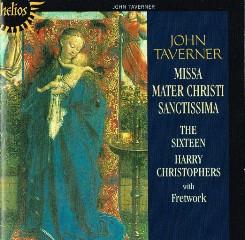John Taverner - Missa Mater Christi Sanctissima (2000)
John Taverner - Missa Mater Christi Sanctissima (2000)

1 Hodie Nobis Coelorum Rex 4:59 2 Mater Christi Sanctissima 7:21 3 Magnificat a 4 - Nesciens Mater 11:46 4 Quemadmodum a 6 4:21 Missa Mater Christi Sanctissima (34:17) 5 Gloria 8:17 6 Credo 8:03 7 Sanctus 6:17 8 Benedictus 4:55 9 Agnus Dei 6:43 10 In Nomine a 4 2:27 The Sixteen Harry Christophers - conductor Fretwork (Ensemble) (tracks: 4, 10)
Continuing their series of recordings of the works of John Taverner, The Sixteen now offer their impressive account of the composer's five-part Missa Mater Christi sanctissima, based on his votive anthem of the same name. It is a lively and vigorous work, beautifully crafted, and this performance amply matches the craftsmanship of the composer. The Sixteen are not the first choir to have recorded this work: four years ago the choir of Christ Church, Oxford, made a splendid recording with Stephen Darlington. Christ Church would appear to have held all the trump cards: in the first place, because Taverner wrote this Mass for this very choir, of which in the sixteenth century he was informator, the choir of what was then Wolsey's Cardinal College. The composition of the choir was the same then as now, with 16 boy trebles. Furthermore, the acoustic would have been identical. What more could a present-day, authenticityseeking conductor desire? To make their performance even more 'authentic', the choir had attempted to place it in its correct liturgical setting—in a mass celebrated according to the rite of Salisbury.
Possessing none of these 'inherited' advantages, Harry Christophers approaches the Mass from a different angle. He attempts no liturgical reconstruction, concentrating instead upon sheer musical quality. Three female sopranos replace the boy trebles. The music is all pitched up a tone, which has the effect of adding brilliance to every climax. He demonstrates the surprisingly good acoustic of St Jude-on-the-Hill in Hampstead—an acoustic of space and definition, ideal for the interweaving of the strands of early Tudor polyphony. His slightly slower tempo than that adopted by Darlington makes for greater clarity and a certain welcome gravitas. Without being told so, I might have been able to recognize, in the quality of the recording, the hand of Antony Howell: clarity and a sense of space are its hallmarks. In addition, there is an ease and elegance about this performance by The Sixteen, which shows itself in many ways, not least in the careful sculpting of the individual phrases, but also in attention to such details as the cadential triplets in the treble part at "de Deo VE-ro" (in the Credo—indicated by coloration and the proportional sign 3.2 in the part-book). -- Gramophone, arkivmusic.com
When James O’Donnell was in charge of Westminster Cathedral Choir, he produced a discography rich with the ebony and gold music of Renaissance Italy and Spain. Since 2000, when he moved to the other end of Victoria Street and took control of the choir of Westminster Abbey, his focus has shifted to the dense greenery of Tudor polyphony. In this recording of John Taverner’s Mater Christi sanctissima, Francis Steele’s reconstruction of the Missa Mater Christi sanctissima, and the Western Wynde Mass, the difference between the two choirs is more obvious than ever. Where the Cathedral choristers developed a bright, sophisticated, Continental timbre, the boys of the Abbey sound airy, innocent and very young.
Their lightness provides an arresting contrast to the burnished blend of the Abbey’s tenors and basses, with a clean, pure alto line to bridge the gap, most effectively in the opening stanza of Taverner’s motet. To those listeners who are used to hearing adult sopranos voice the elaborate imagery of Marian motets, it is odd to hear such leafy simplicity. At best, the openness and lack of guile is refreshing. On occasion, however, the trebles tackle Taverner’s intricate melismatic writing like novice skiers. This nursery slope giddiness is most pronounced in the Gloria and Sanctus of the first Mass. O’Donnell favours brisk tempos throughout, much to the benefit of the Western Wynde Mass. It’s a robust, rhythmic, grounded performance, and is presented with pithy liner notes by Jeremy Summerly, but I won’t be trading in The Tallis Scholars or The Sixteen. ---Anna Picard, classical-music.com
download (mp3 @320 kbs):








